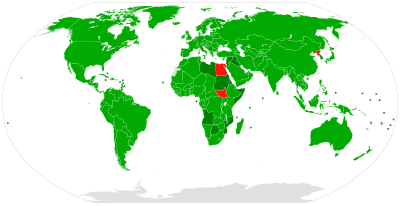Chemical Weapons Convention
| Convention on the Prohibition of the Development, Production, Stockpiling and Use of Chemical Weapons and on their Destruction | |||
|---|---|---|---|

Participation in the Chemical Weapons Convention
|
|||
| Drafted | 3 September 1992 | ||
| Signed | 13 January 1993 | ||
| Location | Paris and New York | ||
| Effective | 29 April 1997 | ||
| Condition | Ratification by 65 states | ||
| Signatories | 165 | ||
| Parties | 192 (List of State Parties) Four UN states are not party: Egypt, Israel, North Korea and South Sudan. |
||
| Depositary | UN Secretary-General | ||
| Languages | Arabic, Chinese, English, French, Russian and Spanish | ||
The Chemical Weapons Convention (CWC) is an arms control treaty which outlaws the production, stockpiling, and use of chemical weapons and their precursors. The full name of the treaty is the Convention on the Prohibition of the Development, Production, Stockpiling and Use of Chemical Weapons and on their Destruction and it is administered by the Organisation for the Prohibition of Chemical Weapons (OPCW), an intergovernmental organization based in The Hague, Netherlands. The treaty entered into force in 1997. The parties' main obligation under the convention is to prohibit the use and production of chemical weapons, as well as the destruction of all current chemical weapons. The destruction activities are verified by the OPCW.
As of April 2016, 192 states have given their consent to be bound by the CWC. Israel has signed but not ratified the agreement, while three other UN member states (Egypt, North Korea and South Sudan) have neither signed nor acceded to the treaty. Most recently, Angola deposited its instrument of accession to the CWC on 16 September 2015.
As of October 2015, about 90% of the world's declared stockpile of chemical weapons had been destroyed. The convention has provisions for systematic evaluation of chemical production facilities, as well as for investigations of allegations of use and production of chemical weapons based on intelligence of other state parties
Intergovernmental consideration of a chemical and biological weapons ban was initiated in 1968 within the 18-nation Disarmament Committee, which, after numerous changes of name and composition, became the Conference on Disarmament (CD) in 1984. On 3 September 1992 the Conference on Disarmament submitted to the U.N. General Assembly its annual report, which contained the text of the Chemical Weapons Convention. The General Assembly approved the Convention on 30 November 1992, and the U.N. Secretary-General then opened the Convention for signature in Paris on 13 January 1993. The CWC remained open for signature until its entry into force on 29 April 1997, 180 days after the deposit of the 65th instrument of ratification (by Hungary). The convention augments the of 1925 for chemical weapons and includes extensive verification measures such as on-site inspections. It does not, however, cover biological weapons.
...
Wikipedia
